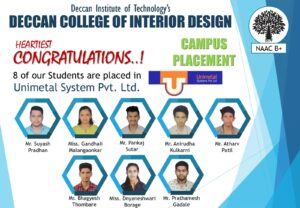Program Specific Outcome
- The word Design indicates that it is a systematic effort to analyse the end product, understand its function and design with such ingenuity as to have a unique combination of appropriate material, technology and aesthetic values to blend with choice of material and end use selected.
- In today’s world where all activities are market driven, the importance of designing the environment with total emphasis on human comfort and sustainability is the mantra to succeed.
- It is also pertinent to note that a lot of research has been carried out on the psychological and visual aspects of Design and it is proved that the faculty of human being to produce more and with creativity gets enhanced in such well-planned and aesthetically designed environments.
- Well planned office buildings with work conducive interiors, well laid out landscaped gardens; Supplement by minute detailing of product design signage etc. is an example of well-planned environment.
- This course is being introduced young and sensitive designers in various disciplines such as Interior Design, Product Design, Furniture Design, Set Design, and Visual Communication.
- Due to globalization and GATE trade agreements in force, the Designers will have ample scope to work anywhere in the world and enhance the quality of work of human life around.
- Since Shivaji University is one of the pioneers to start this course, we feel that this and it will be able to provide good outlet to young talented Designers to show their creativity.
- Since this is a self-employment-oriented course, graduates are likely to practice independently or alternatively find jobs with Corporate Offices, Industrial Houses, Films and Advertisement Industry etc.
- By considering limitations regarding – (1) Response of students (2) Infrastructure available in institute, we have started only one course i.e. Interior Designing for this academic year 2006- 2007.
- In syllabus we have tried to give every student the opportunity to in the degree course. We would like to give them opportunity for further higher studies. This providing some qualified Interior Designers to ever demanding designing profession.
Program Outcome
The Vision, Mission of the institute along with the under graduate attributes given by the UGC and Shivaji University, Kolhapur are used in defining the Programme and course outcomes. They are also displayed on the college website and made available in soft and hard copy in the library.
1.Demonstrate ability to identify, analyse and solve interior design problems.
Assessment: Studio portfolio design projects appropriately respond to project criteria, design requirement and focused on expressive and communicative solutions to the stated problems. Apply learned design elements and principles to solve the design problem. Communicate solutions through 2D and 3D drawings, colour theory and proper specifications of materials.
2.Demonstrate mastery of design techniques and concepts in interior design.
Assessment: design projects of each semester show evidence of attention to detail, adherence to project-initial concepts throughout the process, and close attention that the initially presented concept implemented in the outcome. Projects show furniture details with appropriate selection and implementation of materials, finishes, furniture, and fabrics.
3.Demonstrate an understanding of aesthetics and scale related to interior space, and its application in the history and current interiors.
Assessment: PowerPoint presentations for art and history in course work. In studio courses, assign projects that appropriately apply reference historical precedents and stylistic movements in interior design, bringing forward current thoughts in interior design with reference to the past. Through working drawing portfolio show knowledge of scale though appropriate furniture and specifications.
4.Demonstrate proficiency in selection and use of relevant technologies in design and in using available technologies to produce a design presentation.
Assessment: Drawings including floor plans, elevations, sections, rendered perspectives, and models made with the appropriate technology or software for the final presentation.
5.Demonstrate an understanding of the cultural and societal connections linking interior design trends and processes as well as a knowledge of business practices and of the market place.
Assessment: Project solutions that are culturally and audience appropriate for the problem as posed by the criteria for the project. Awareness of the current marketplace based on materials and mechanicals specified for studio projects, projects for Business practices course work.
6.Demonstrate proficiency in presenting their own work as well as discussing and constructively critiquing the work of others.
Assessment: Presenting ones work with confidence and a working knowledge of the criteria and materials presented, active participant in class critiques; clear, thoughtful and honest ability to give, accept and incorporate feedback.



